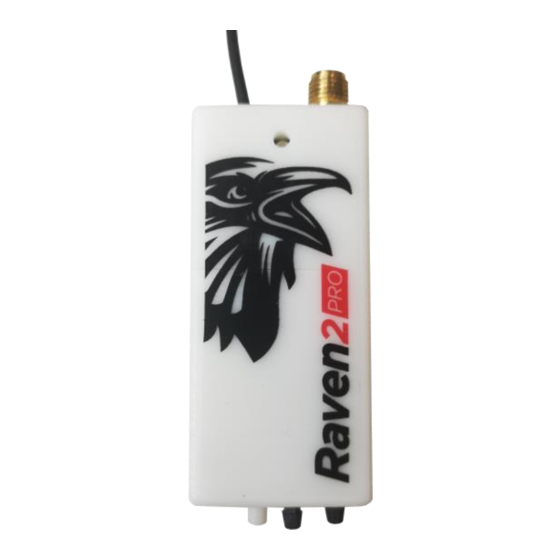Summary of Contents for RC Electronics Raven2 PRO
- Page 1 Raven 2 PRO Onboard air-data measuring system for R/C aircraft with telemetry. Manual version: 1.0 RC Electronics support@rc-electronics.eu; www.rc-electronics.eu...
-
Page 2: Table Of Contents
Contents Introduction ..............................3 Key features of the Raven ........................3 Specifications ............................3 Physical overview ............................4 Using the Raven 2 PRO module ........................6 Powering the module ..........................6 Mounting the module ..........................6 Connecting module to PC ..........................9 Modes of operations ........................... -
Page 3: Introduction
Introduction The “Raven 2 PRO” is one component of RC Electronics model aircraft telemetry system. The unit is the “on-board” unit intended to be used with the “Snipe / Finch” “ground station”. The unit is designed to measure many parameters of an R/C model aircraft and transmit them to the ground station via the telemetry link working on 433 MHz frequency. -
Page 4: Physical Overview
Physical overview Pictures bellow are showing the Raven 2 PRO unit. It has one SMA connectors for active GPS antenna, 3 pressure ports (Ptot – total pressure, Pst – static pressure, Pte – total energy compensated pressure from TEK probe) and a multi-color LED to show the status of the unit. It also has 3 connectors. The micro USB is used for future updates, settings and flight log download. - Page 5 SMA connector for GPS antenna There are 2 ways of connection Pte port: 1: When using normal TEK probe, connect it Multi color LED to Pte port and vario will be calculated from measuring compensated pressure at TEK probe. Connect IAS probe to Ptot. IAS 2: When using electronic compensation probe can be mounted in nose or connect Pte port to Pst port.
-
Page 6: Using The Raven 2 Pro Module
Using the Raven 2 PRO module Powering the module To power the module plug the 3 pin female connector cable into servo connector and the other end to the R/C aircraft receiver. Be sure to observe proper polarity when plugging the connector into the module and receiver. - Page 7 GPS antenna has to be mounted where there is no metal or carbon above it and must be turned in such direction that GPS label written on antenna is facing towards the sky. Correct position of GPS antenna Raven - Onboard air-data measuring system for R/C planes with telemetry. Page 7 2 PRO...
- Page 8 Static tube installation In order to utilize the full capability of the Raven 2 PRO an Indicated Airspeed (IAS) probe must be install in the aircraft. The IAS probe must have two components, Ptot (total air pressure) and Pst (Static Air pressure).
-
Page 9: Connecting Module To Pc
Raven 2 PRO. When connected to the PC the module will power up and will create a new Virtual COM port. Run RC electronics device tool software (published on our website under Download / Software section) Select correct COM port and then press select. -
Page 10: Modes Of Operations
Modes of operations Electronic compensation Electronic compensation can work only when an IAS probe (Indicated Airspeed) is installed in aircraft and connected to Raven 2 PRO. It is used when the user wishes to fine tune the TEK probe (TEK probe can be over or under compensating dynamic change of plane). -
Page 11: Firmware Update
Raven_2.rcu 2. Connect Raven to PC via USB cable 3. Use RC electronics device tool software. Can be downloaded from our web site 4. Select correct COM port and press Connect button 5. Wait until you see Device Info (connected device and FW version of it) 6.







Need help?
Do you have a question about the Raven2 PRO and is the answer not in the manual?
Questions and answers